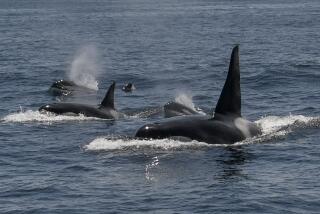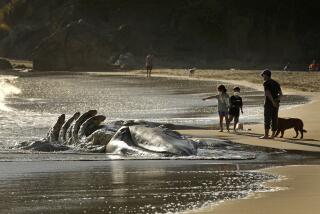Warmth of Celebrity Status Greets Scientist Who Rescued Whales
- Share via
Ron Morris is leaning back in a booth at the fancy palm-graced Bel Age Hotel sipping coffee and chatting about possible book and movie deals, just like any another Hollywood type. Of course, most people might not recognize Morris in spiffy gray suit and tie.
But put him back in his working duds--giant gray parka trimmed with fake fur, and think of him standing on an ice floe near Pt. Barrow, Alaska, and then the recognition might dawn. He’s the guy who had the news spotlight for two weeks last month--the marine biologist who led the grueling, emotional “Operation Breakthrough” rescue mission, which succeeded in saving two of three gray whales trapped by Arctic ice.
Since the lifesaving effort, Morris, who is a regional director of the National Oceanic and Atmospheric Administration, has become a celebrity of sorts--courted by Hollywood deal makers, thanked by President Reagan, interviewed by journalists, asked to speak at fancy social gatherings and the recipient of hundreds of letters from schoolchildren and animal lovers around the world. But the soft-spoken scientist, who has spent most of his life shuffling papers for the federal government, seems to be taking it all in stride.
Morris, in Los Angeles this weekend to speak at the Fund for Animals’ “Genesis” awards luncheon, tries to shrug off the accolades and attention he has received. “It was just my job. I just pushed the buttons,” he said, preferring to give credit to the hundreds of others who participated in the rescue operation.
Cooperation At Its Best
“It was a demonstration of humankind working together at its best,” he said.
But most give Morris credit for putting together and holding together the unlikely team of hundreds of Eskimos, Soviet seamen, National Guard troops, oil workers, environmentalists and scientists, who spent two weeks laboring in sub-zero weather to make breathing holes in the ice with chain saws to lure the gray whales to open sea miles away.
Morris, who grew up in New York City and majored in fish and wildlife biology at Colorado State University, has spent most of his career doing research on environmental concerns--including the effects of pesticides on fish, pheasant and antelope in Colorado and, more recently, calculating harm to marine life during construction of the Alaskan pipeline. For the last several years, his work has been mostly managerial, and he never dreamed he would be involved in rescuing marine mammals weighing about 28,000 pounds apiece.
Greenpeace Called
Morris, who is based in Anchorage, became involved in the drama of the whales on Oct. 13, when he received a call from Greenpeace environmentalists looking for an ice cutter to help the stranded sea mammals. He found an oil company that could help out, but as the problems mounted, he found himself at the center of the rescue operation.
During the two weeks, Morris worked around the clock, losing not only sleep but nearly 10 pounds as well. The crew tried smashing channels in the ice for the whales, but the openings froze over too fast. The biggest disappointment was the disappearance and apparent death of one of the weaker whales. But the workers finally prevailed, and Eskimos using chain saws saved the other two whales from an icy grave.
Since then, Morris has had offers for movies, books and public appearances. Even his daughter, a college journalism major, is asking him for “first rights” on it, he laughed. He hasn’t acted on any of the offers and says his life has not changed dramatically. He and his wife, Kate, a psychiatric nurse, will spend most of the long Arctic winter reading and playing cards.
Morris and other scientists believe the whales headed south for the winter to the waters off Baja California. Morris joked that he will follow suit. He plans to spend Christmas in Hawaii.
Only a handful of skeptics have complained about spending $1 million on the rescue. One major news network even polled watchers, who turned out to be 90% in favor of tax money being spent on the rescue.
The more typical response was enthusiasm. When one woman was introduced to Morris, she broke down crying, saying she was overwhelmed by what he and his staff had done.
“I’ve thought about it often since then, why the rescue captured the imagination of the world,” Morris said. “The whales aren’t that pretty and they are awfully big. I think it’s association. People don’t like to be trapped, they like freedom and wished it for the whales. And it was life-and-death suspense, and a clean and neat problem that was solveable, when so much involving the environment today isn’t.”
More to Read
Sign up for Essential California
The most important California stories and recommendations in your inbox every morning.
You may occasionally receive promotional content from the Los Angeles Times.










